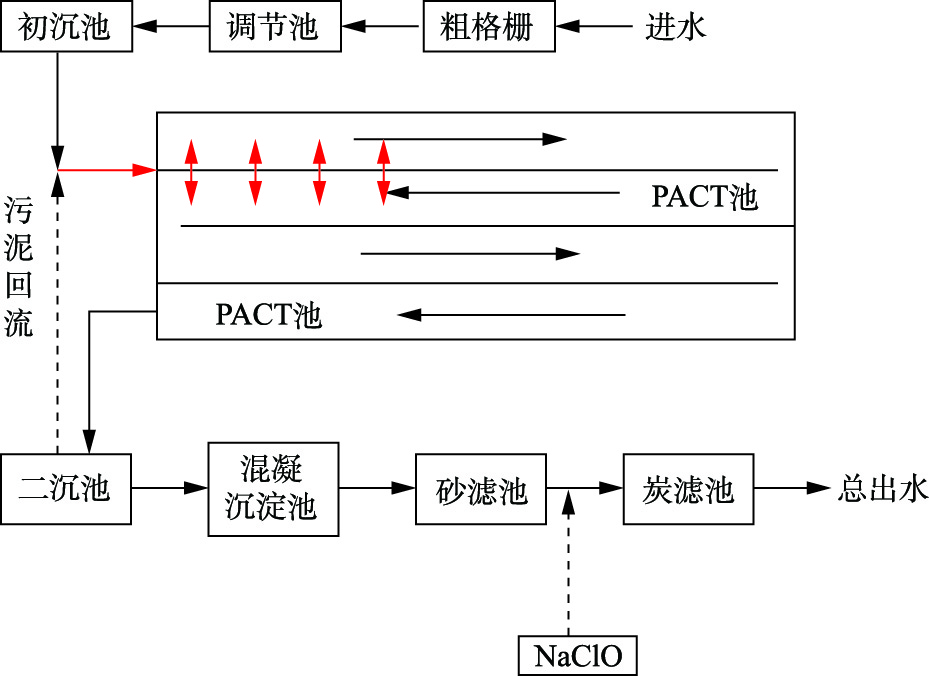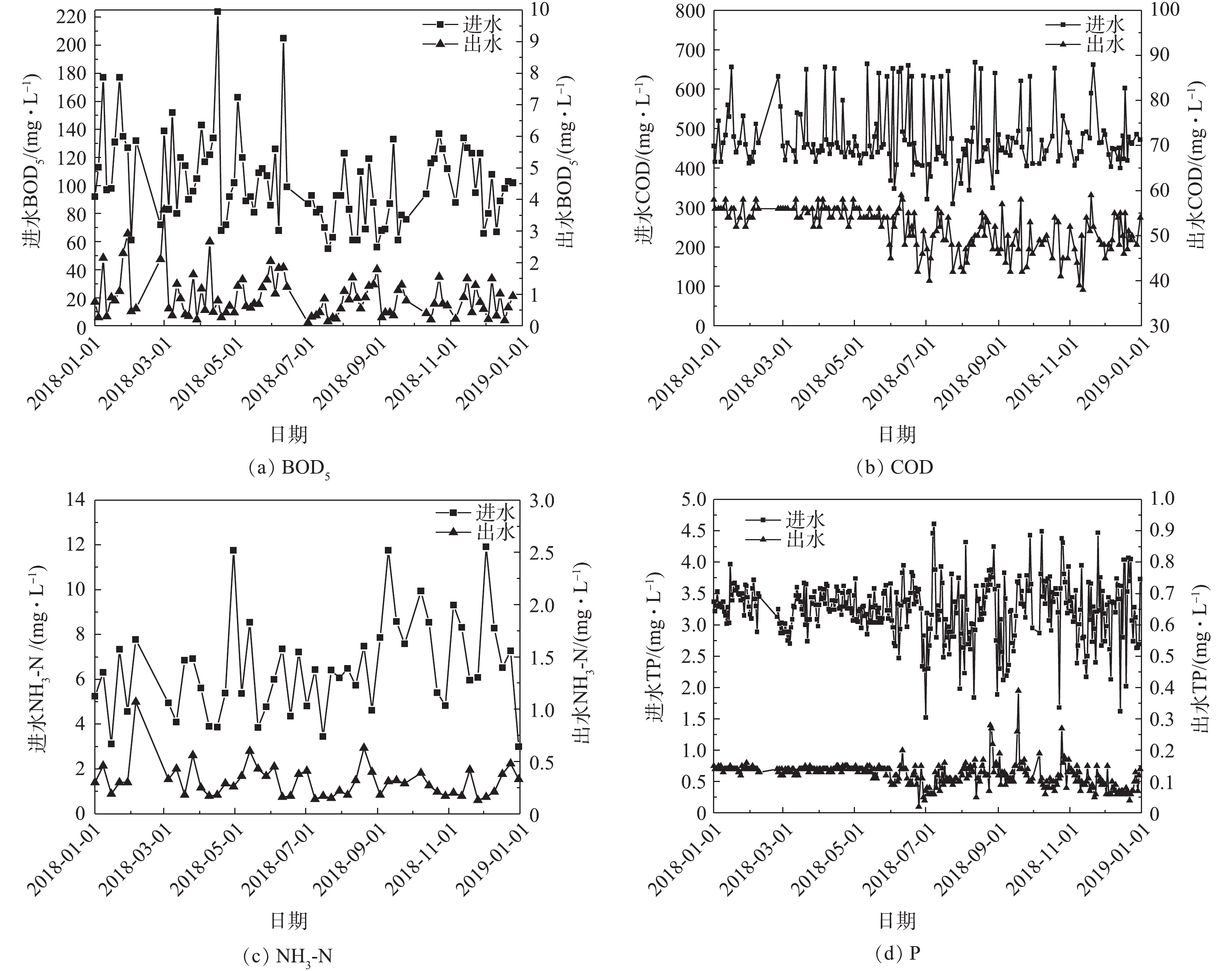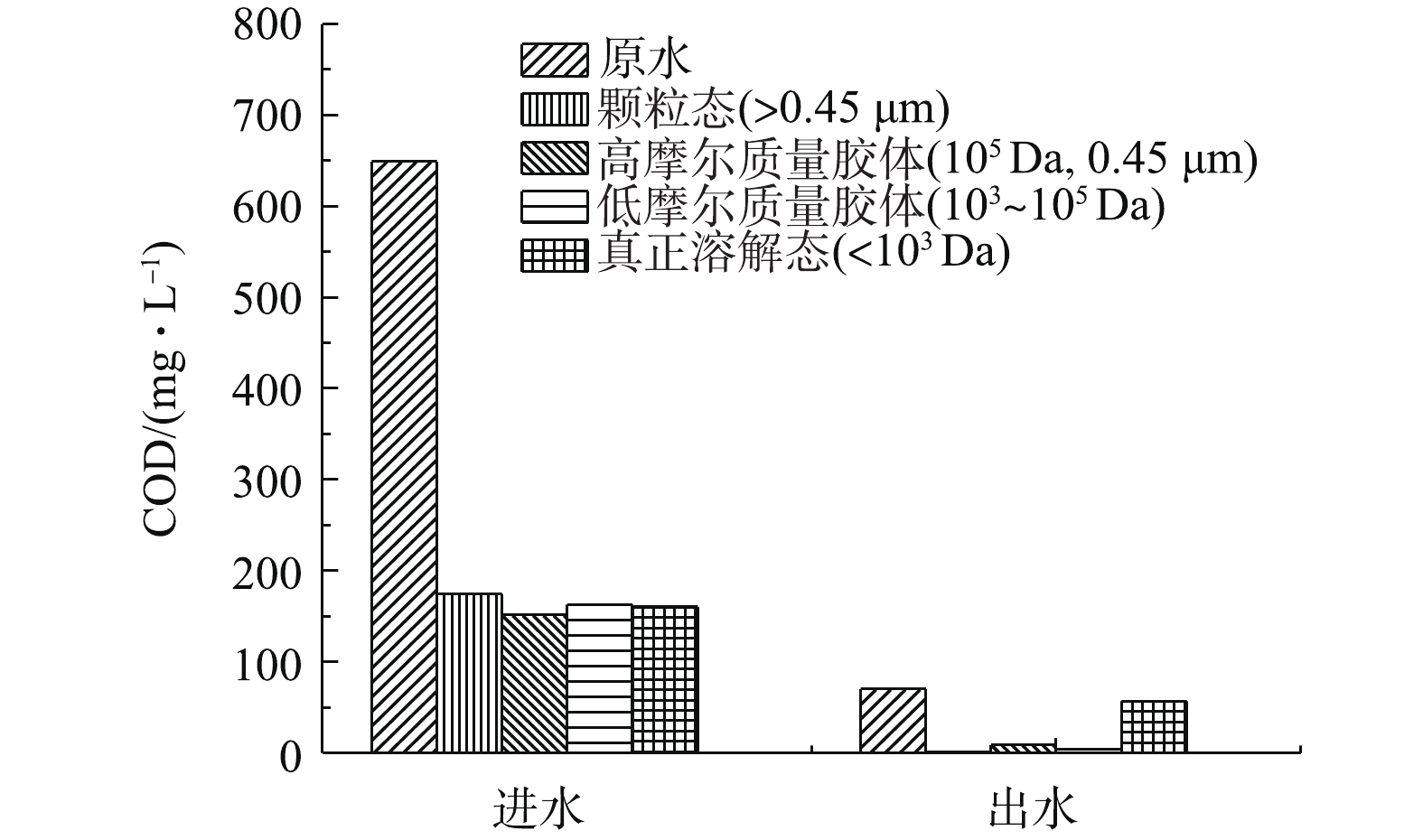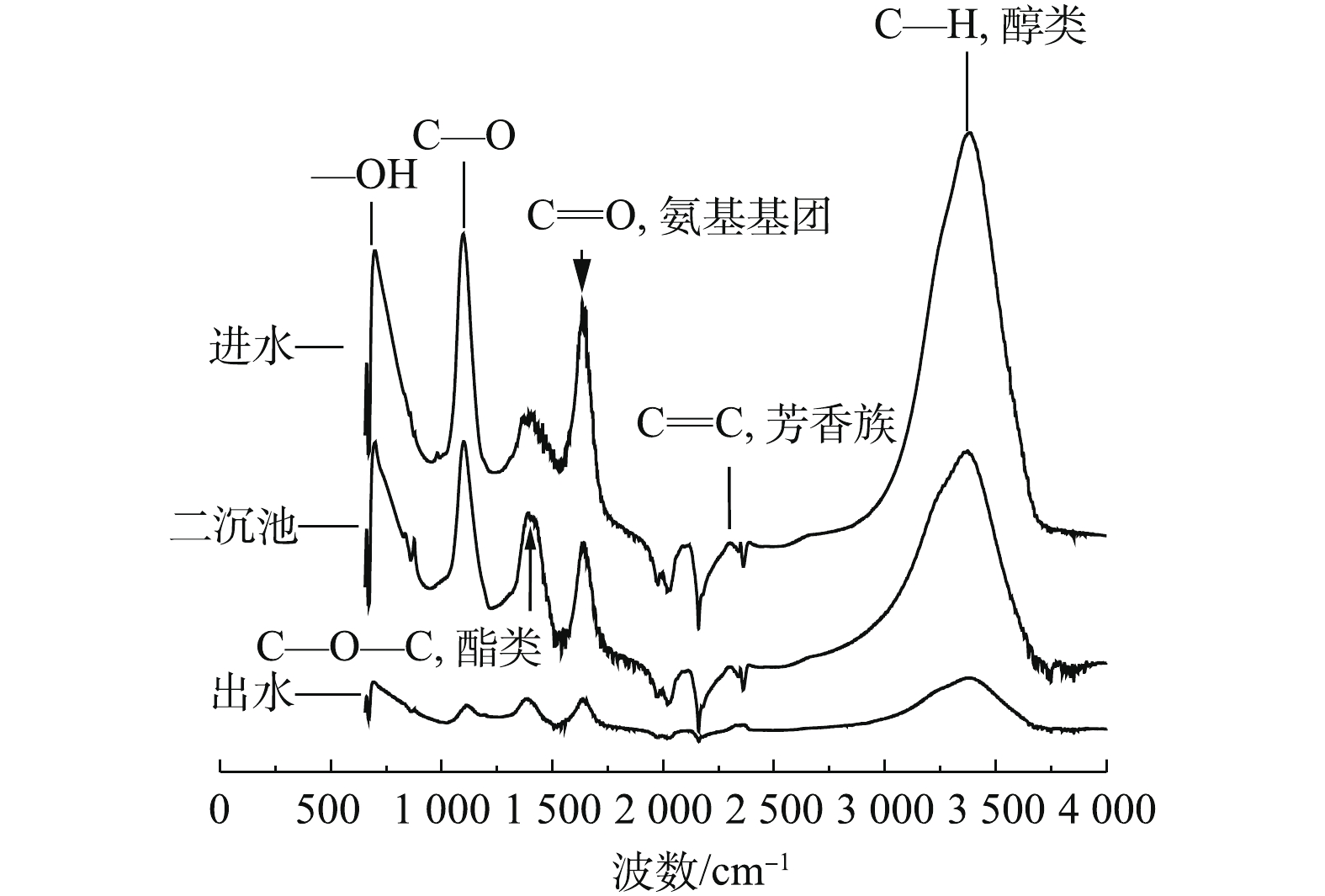-
印染园区废水处理在水污染治理方面的重要性日益突出,以江苏省太湖流域为例[1],流域内建有印染企业5 000家,平均每年排放约1×108 m3印染废水[2]。由于纺织产品在生产过程中使用的原料较为复杂且需要后续的漂洗等步骤[3],印染园区排水中会携带大量难生化降解的有机物,使印染废水的组成成分波动较大且较难处理[4]。因此,针对江苏省出台《太湖地区城镇污水处理厂及重点工业行业主要污染物排放限制》(DB 32-2018)新标准[5],印染园区废水处理工艺需要结合水质特性,分析处理主要达标污染物,为优化运行及提标改造提供基础数据。
目前,对印染废水的研究主要集中在新工艺的开发及现有工艺参数优化,如树脂吸附、离子交换处理工艺[6]、铁碳微电解技术等[7],所研究的印染废水来源较为单一,且新工艺在工程应用中仍存在很多问题[8]。而针对DB 32-2018新标准,印染园区集中废水综合排放的达标难点及其特征DOM解析鲜有研究。
本研究以太湖流域某印染园区中集中废水处理厂为研究对象,分析有机物、氮、磷等污染物的变化规律和水质特征,确定该厂存在达标难度的指标。探讨了粉末活性炭处理(powered activated carbon treatment, PACT)-过滤集成工艺处理印染废水过程中的溶解性有机物(dissolved organic matter,DOM)的去除特性及其迁移转化规律,对有机物组分进行了全流程特征分析,探究印染废水及总出水中有机物组成,为类似废水处理提供借鉴参考。
全文HTML
-
该印染园区污水处理厂设计规模为30 000 m3·d−1。上游企业主要为织布厂、丝绸厂、毛巾厂、棉染厂等。印染废水类型主要包括煮炼废水、印花废水、整理废水和洗涤废水,废水中有机污染物主要来源于染色过程中使用的染料、新型助剂和表面活性剂等。
印染园区废水处理厂进水水质按照园区接管标准制定,污水处理厂目前执行《太湖地区城镇污水处理厂及重点工业主要水污染物排放限值》(DB 32-2007),提标改造后需执行DB 32-2018标准中的一二级保护区排放限值。设计进出水水质见表1。
工艺流程如图1所示。工艺主要分为3级处理:第1级为物化处理,即印染废水经过格栅过滤,以除去水中漂浮物等杂质,经过调节池起缓冲和调节酸碱的作用;第2级为生物处理,主体工艺为PACT工艺,通过PACT吸附降解大分子有机物;第3级为深度处理,通过砂滤和活性炭滤对出水的色度和COD进行进一步的去除。主要构筑物参数如表2所示。
-
水质参数如BOD5、COD、NH3-N、TN、TP等指标根据《水和废水监测分析方法》[9]测定。采用切向流超滤装置对有机物的表观分子质量分布进行分级。废水样品首先通过0.45 μm玻璃纤维滤膜过滤,去除颗粒态物质。然后,在氮气罐的压力(0.2 mPa)驱动下,将约300 mL废水样品通过超滤膜滤出。在本研究中所使用的超滤膜分子质量阀值分别为1 kDa和100 kDa。废水收集在玻璃瓶中,并储存在4 ℃下待测。
待测样品首先需要使用超纯水进行稀释,保证总有机碳(total organic carbon,TOC)在10 mg·L−1,采用日立F7000荧光分光光度计进行三维荧光(excitation emission matrix spectra,3D-EEM)测试。本实验以10 nm为增量,激发波长为220~450 nm,发射波长为270~600 nm,扫描速度为12 000 nm·min−1[10],最后使用Origin软件对三维荧光光谱数据进行处理[11]。
采用傅里叶红外光谱(fourier transform infrared spectroscopy,FT-IR)对化合物进行定性分析,分析光谱图中的出峰位置以判断样品中可能含有的官能团结构[12]。实验采用红外光谱仪(VERTEX 70型,德国),扫描波数为4 000~400 cm−1,实验前将水样在干燥机中进行风干,然后将风干后的样品磨成粉末,最后利用红外光谱仪进行扫描[13]。
样品预处理采用固相萃取方式,首先依次用5 mL二氯甲烷和10 mL甲醇清洗和活化固相萃取柱,进样后依次用4 mL甲醇/乙酸乙酯(50∶50)和2 mL含1.7%甲酸的甲醇/乙酸乙酯(50∶50)进行洗脱,最后采用氮气进行吹脱,定容样品至1 mL [14]。采用美国赛默飞世尔科技有限公司的气相色谱-质谱联用仪(gas chromatography-mass spectrometer,GC-MS)进行实验,仪器型号为TSQ8000,色谱柱为DB-35毛细管色谱柱[15]。最后根据测试结果对各个样品测得有机物质的相对丰度和峰面积对有机物含量进行占比计算,各组分浓度以面积百分率表示,按照式(1)进行计算。
式中:Ai为各物质的峰面积;Ci为各物质的相对丰度。
1.1. 污水厂概况
1.2. 分析方法
-
日常进出水水质数据是衡量该污水处理厂当前运行状态的最佳工具,因此,对该污水处理厂的工艺运行现状进行了针对性调研和实验分析。通过分析该厂近1年的进出水水质数据,研究有机物、氮、磷等污染物的变化规律和水质特征,初步确定该厂存在达标难度的指标。2018年进出水水质(BOD5、COD、NH3-N、TP)结果见图2和表3。可以看出,该污水处理厂进水BOD5在55~225 mg·L−1波动,均值为103 mg·L−1,出水BOD5稳定在4 mg·L−1以下;进水COD为300~670 mg·L−1,波动较大,均值为477 mg·L−1;出水COD基本稳定在55 mg·L−1左右,未能达到DB32-2018标准;进水NH3-N浓度在3.00~12.00 mg·L−1,均值为6.46 mg·L−1;出水NH3-N除在2月26日为2.11 mg·L−1外,其余时间均在0.10~1.10 mg·L−1;出水TN处于1.50~11.01 mg·L−1,均值为5.39 mg·L−1;进水TP基本稳定在1.50~5.02 mg·L−1,均值为3.25 mg·L−1;出水TP浓度除个别值外,大多分布在0~0.30 mg·L−1。上半年进出水TP的波动明显小于下半年,上半年出水TP浓度基本在0.15 mg·L−1左右,虽下半年的出水TP波动较大,但其出水浓度除个别值外也基本低于0.30 mg·L−1,基本不存在DB 32-2018标准的达标难度。
由图3可以看出,进水SCOD/COD约为81.3%,进水中可溶性有机物(以COD值计)较高,经过粗细格栅、调节池的处理后,COD的去除效果均不明显,初沉池出水COD约为340 mg·L−1,进入好氧池后,由于微生物的好氧降解作用,好氧池的COD降低到65 mg·L−1左右;经混凝沉淀、砂滤和炭滤后总出水COD为45 mg·L−1左右,无法实现DB 32-2018标准(40 mg·L−1)的达标排放。进水STN/TN为47.3%,这表明进水中大部分TN为颗粒态TN。TN在预处理段去除量较少,主要在生化段被去除,在PACT池前中段中的活性污泥的反硝化作用将进水和回流液中携带的硝态氮去除,中段末端
NO−3 -N浓度为1.51 mg·L−1,好氧末端出水中由于硝化作用,导致NH3-N降至0,这表明硝化效果较好;总出水TN含量达7.00 mg·L−1,其中NO−3 -N为6.11 mg·L−1,说明出水中以NO−3 -N为主,且能达到DB 32-2018排放标准(TN为10 mg·L−1,NH3-N为3 mg·L−1)。进水STP/TP约为30%,说明进水中存在大量颗粒态磷。由于调节池前端搅拌器间歇启动,该点TP波动较为明显。磷酸盐浓度始终维持在较低水平,无明显释磷现象。在混凝沉淀池投加除磷药剂,对磷进行深度处理,最终出水TP为0.11 mg·L−1,能达到DB 32-2018标准(0.30 mg·L−1)排放要求。如表3所示,出水COD低于50 mg·L−1的占比约为33%,而低于40 mg·L−1的占比不到1%,除COD外,其他各项出水指标均可达到DB 32-2018标准,因此,COD是新一轮印染废水处理提标改造需重点去除的指标。图4为印染废水的进出水有机物粒径和分子质量分级结果。可以看出,进水中的有机物在各个粒径和分子质量范围分布均匀,颗粒态(粒径>0.45 μm)COD为174 mg·L−1,占比达到26.8%。出水中颗粒态有机物仅占0.14%,而溶解性(粒径<0.45 μm)有机物组分占比达到98.6%,其中分子质量<1 kDa的组分占81.4%,这表明颗粒态及部分大胶体物质经过各工艺段处理后得到有效去除,出水中难降解有机物基本存在于分子质量<1 kDa的组分内,因此,出水中的难降解DOM为主要达标难点。为深入了解印染园区废水中的有机污染物特征,须进行相关检测实验,探究印染废水中难降解有机物的迁移转化规律。
-
相较于生活污水,印染废水中成分较为复杂,因此,其荧光特征具有特异性[16],三维荧光光谱可以通过其荧光强度的变化来体现相对物质的变化规律[17],测试结果如图5所示。污水样品在三维荧光中基本存在4个荧光峰区域[18],其中区域A(Ex/Em=(220~250) nm/(280~330) nm)和区域B(Ex/Em=(220~250) nm/(330~380) nm)分别为芳香族蛋白类物质和酪氨酸/色氨酸类蛋白;区域C(Ex/Em=(280~310) nm/(380~455) nm)为类富里酸;区域D(Ex/Em=(300~330) nm/(360~390) nm)为多糖类物质区。芳香族蛋白类物质的荧光强度与水样中有机物含量呈显著正相关关系,可以在一定程度上反映样品的有机物浓度[19]。由图5可知,芳香类蛋白物质区域荧光强度从进水至出水呈现明显降低趋势,说明经过PACT及混凝沉淀工艺,可对印染废水中的芳香类物质实现较好的去除,且经各级处理之后色氨酸类物质被显著去除,出水中荧光特征峰明显减弱,这说明炭滤池对印染废水中的有机物质的去除效果较好,大部分有机物均可被有效去除。王士峰[20]指出,分散浆料中具有Ex/Em=230 nm/340 nm和Ex/Em=280 nm/320 nm附近的特征荧光峰,该荧光峰位置与图5中印染废水各工艺段的三维荧光谱图中的峰位置相近。由此推测,该类分散浆料极有可能是印染废水产生荧光强度的来源。
图5显示,初沉池、二沉池和混凝沉淀池的出水检测到的光谱特征都较相似,在区域A、区域B和区域C附近均存在强度较高的荧光峰。而总出水只在区域A和区域C附近检测到荧光峰,这说明经过炭滤吸附后,酪氨酸/色氨酸类物质被吸附去除,但仍然部分微生物代谢产物残留,如类富里酸和多环芳烃类腐殖酸等物质[21]。该类物质为惰性物质,较难被生物降解或吸附降解[22],因此,在出水中仍保留一定的荧光强度。且富里酸类物质可加快微生物自身代谢[23],协助细胞内的酶进行催化反应,以此提高微生物活性,从而更好地适应进水水质的波动及其他外界的变化[24]。色氨酸类蛋白与污水中的芳环氨基酸类物质结构有关[25],这与下文中的有机物组成分析具有良好的对应关系。
-
傅里叶红外光谱分析(FT-IR)能定性地找到有机化合物分子结构信息,还可以揭示处理过程中有机物的去除特性[26]。图6为印染废水、二沉池出水及总出水的FT-IR光谱。印染废水经由生化段处理及炭滤处理后,各样品中特征吸收峰出峰位置(即官能团种类)基本没有发生变化,但经处理后各官能团的响应强度均有显著降低,其中代表性官能团主要分为以下几类:在3 400~3 250 cm−1处有较明显的C—H对称伸缩振动谱带,这说明水样中有机物质较多,可能存在醇类、酚羟基类或苯酚类物质,该类物质较易被降解去除;在2 400~2 000 cm−1处发现有较弱的不饱和C=C双键和C≡N三键伸缩振动吸收峰,说明废水中存在含氮类有机化合物和芳香类物质。由于炭基吸附剂对该类疏水性物质有较好的吸附效果,因此,经过炭滤池后该类峰强度明显减弱;在1 700~1 350 cm−1处存在多个与C=O和N—H相关的反对称伸缩振动吸收峰以和—CH2伸缩振动吸收峰,这说明可能存在酯类或长链有机物质或酰胺类化合物,可能为某类微生物代谢产物,这与GC-MS分析检测出的酚、酮、醇和芳香族类有机物的分析结果基本一致;在1 400 cm−1处存在明显的C—O—C伸缩振动峰,这说明可能存在某类染料中间体为醚类物质。
-
以上对各处理单元出水水质进行了组分分析,为确定印染废水中的主要有机物成分,利用GC-MS分析了各处理单元出水中所含的有机污染物,筛选出了若干有机物作为特征污染物,以对上游排污企业进行监控,控制印染企业的污染点源排放。对印染废水各工艺单元的DOM成分分析结果见表4,印染废水中主要含有14种物质,包括4种醇、3种酮、2种胺、1种卤代烃和4种苯类衍生物,主要污染物为二氟二苯甲醇与苯胺类物质。经沉淀处理后废水中主要存在12种有机物,包括3种醇类物质、2种酮类物质及多种苯胺类和喹啉类物质。经过预处理后有机物种类减少了2种,醇类和酮类各减少了1种。由于苯胺类和喹啉类物质较易降解,因此,经生物处理后该类有机物得到一定的去除。经过生物处理和炭基吸附剂处理后,二沉池废水中共有11种有机污染物,有机污染物种类和浓度均得到较大地去除。其中4-羟基-4-甲基-2-戊酮的丰度从初沉池的1.36%增至23.52%,表明该类物质较难被生物降解,4-羟基-4-甲基-2-戊酮广泛用于涂漆和染料原料,故其为印染废水中的典型难降解有机物。在经过混凝沉淀池和炭滤等物化深度处理后,出水中有机物成分明显减少,浓度降低,这说明整个处理系统对有机物的去除性能良好。此外,出水中主要成分为2,4'-二氟二苯甲酮和4-羟基-4-甲基-2-戊酮,占比分别为19.46%和15.18%,且这2类物质广泛存在于各工艺单元,且丰度较大,可判断其为该印染园区废水中的特征有机污染物,若因COD达标问题设置深度处理处理单元时,需要重点考虑这2种物质的去除情况。
2.1. 常规指标去除效果分析
2.2. 三维荧光结果分析
2.3. FT-IR分析
2.4. GC-MS结果分析
-
1)采用PACT-过滤工艺处理印染集中废水,出水TN、NH3-N、TP、COD的平均值分别为5.39、0.60、0.20、55 mg·L−1,对污染物的平均去除率为77.1%、94.9%、96.3%、89.3%,除COD外,其他指标基本满足DB 32-2018新标准的要求,故COD是新一轮印染废水处理提标改造需重点关注的指标。
2) 3DEEM和FT-IR分析结果显示,经过生化处理后废水荧光强度显著降低,类蛋白质荧光强度与样品中有机物浓度密切相关,三级处理之后色氨酸被显著去除,出水中的荧光特征峰强度明显减弱,大部分蛋白质与腐殖酸已被去除。印染废水及各工艺单元出水中均存在醇类、酮类、酚类或苯酚类物质,典型官能团以—OH、C=O和C≡N等不饱和键为主。
3) GC-MS分析结果表明,印染废水中主要污染物为二氟二苯甲醇与苯胺类物质。经三级处理工艺后,废水中难降解有机物均得到有效去除,杂环化合物、醇类、酮类和酚类物质得到有效降解。出水中主要成分为2,4'-二氟二苯甲酮和4-羟基-4-甲基-2-戊酮,占比分别为19.46%和15.18%,且这2类物质广泛存在于各工艺单元,且丰度较大,可判断其为该印染园区废水中的特征有机污染物,在设置COD的深度处理处理单元时,需要重点考虑这2种物质的去除情况。



 DownLoad:
DownLoad:








